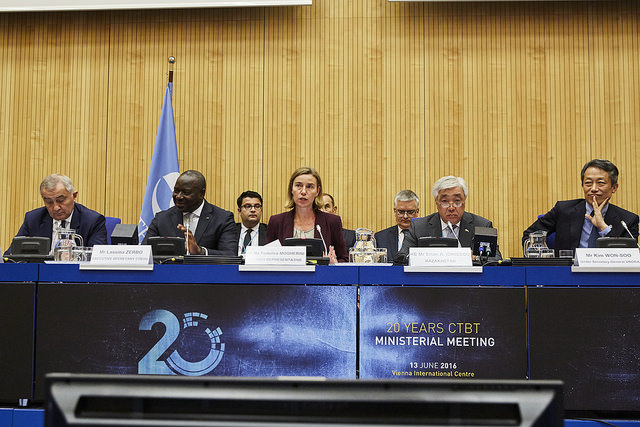The Comprehensive Nuclear-Test-Ban Treaty (CTBT) was agreed in 1996 after more than 2000 nuclear tests had left a lasting, poisonous legacy. The treaty’s negotiations had already contributed to the indefinite extension of the NPT the year before (having contributed to the failures of the 1980 and 1990 NPT Review Conferences). Confidence in arms control and disarmament was high, and nuclear arsenals were falling dramatically. Strategic relations were good. But things look very different today, with high levels of distrust and low confidence in achieving further disarmament progress.
Unlike the NPT, the CTBT is a universal, non-discriminatory treaty in its provisions. It feels like a very practical move that prevents the most public and explicit expressions of a nuclear arms race. Important in its own right, it is often seen as a crucial step in the disarmament journey, a mark of a responsible state, even when it is currently modernising its nuclear arsenal.
Partly a UK idea, entry into force requires ratification by all nuclear-capable states, including North Korea and Egypt. This is a fearsome barrier, but if we are serious we have not only to strengthen the case for the treaty, but also take seriously the doubts and competing commitments that prevent ratification. Traditional objections to the CTBT focusing upon verification and cheating by adversaries are increasingly difficult to sustain as the international monitoring system improves year by year. If they remain today these objections have a shelf life – we are moving towards a world of transparency in which hiding a nuclear explosion is fast becoming an absolute impossibility.
But these objections hide some more fundamental discomforts associated with the treaty’s very purpose. Some treaty advocates seek to assure doubters, saying that a test ban has little impact on weapons design improvements because of the emergence of novel technologies. There are two key problems with this:
- it sends the message that CTBT is irrelevant to disarmament, and simply designed to maintain existing discrimination
- it is untrue, as the long run credibility of nuclear deterrence is undermined both by extended non-use over decades, and by a ban on testing
It is surely better to be upfront with the treaty’s predictable immediate and long term impacts.
A CTBT closes off some future options, even if there is no foreseeable need to test. Emerging nuclear armed states would not be able to signal their unambiguous possession of reliable warheads, and for a period the CTBT would have the effect of freezing nuclear power relationships. In that respect it works with the grain of the old world order and its non-proliferation regime.
But in the very long term a CTBT could also undermine assurance even in established nuclear arsenals, particularly when new designs several generations beyond those that have been tested. Existing warheads may have a longer life than originally feared; novel technologies and powerful supercomputers may strengthen stockpile stewardship over a long period, but reliability and assurance beyond all doubt may not hold indefinitely. As Matt Bunn of Harvard puts it, it is “very difficult to bring on really new nuclear weapons with really new capabilities without testing them”. There are all sorts of reasons to test beyond assuring the particular design actually works with a particular delivery system, including reliability over time, the effects of weapons on other capabilities or impacts, safety, security, training of next generation designers and scientists, and in guarding against technological surprise. And remember, assurance is not just to one’s own leadership, it is also relevant to allies’ confidence, and in delivering a deterrent effect upon the leaderships of adversaries. This is a source of concern for those committed to nuclear deterrence and the health of the nuclear industrial complex that supports it over the long term. CTBT offers the chance for long-term managed decline in the salience of the nuclear weapon enterprise.
CTBT is therefore both a real and an important symbolic step in the long journey away from nuclear deterrence. Its link to disarmament is part of its purpose. But states are not in the disarmament mood right now, and confidence that all Annex 2 states will ratify is very low, even if Israel were to ratify in the near future. It seems unlikely that the incoming US President, whoever it is, will press CTBT ratification anytime soon.
We may have to accept that entry into force is some time away and to consider living with the existing global testing moratorium (with North Korea an exception). The trouble with this is that it holds until it doesn’t. And there may be few penalties for the state that breaks it. So the Security Council could give more explicit signals that nuclear testing is a direct threat to global peace and security, whoever carries it out, and conduct regular reviews with the purpose of agreeing concrete proposals to strengthen the moratorium over time.
These are the views of the author.
Image: CTBT20 Ministerial Meeting June 2016. From left: Lazӑr Comӑnescu, Foreign Minister of Romania and Chair of the CTBTO PrepCom, Lassina Zerbo, CTBTO Executive Secretary, Federica Mogherini, EU High Representative for Foreign Affairs and Security Policy, Erlan Idrisov, Foreign Minister of Kazakhstan and Kim Won-soo, UN High Representative for Disarmament Affairs. Credit: CTBTO, Flickr

